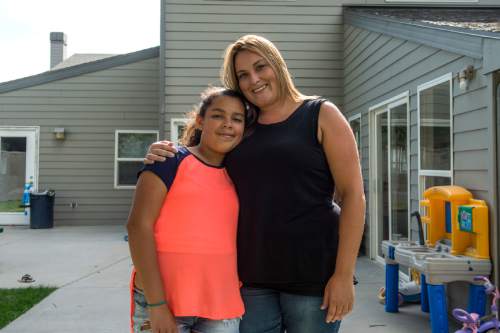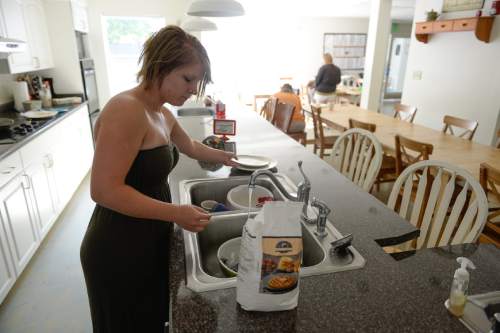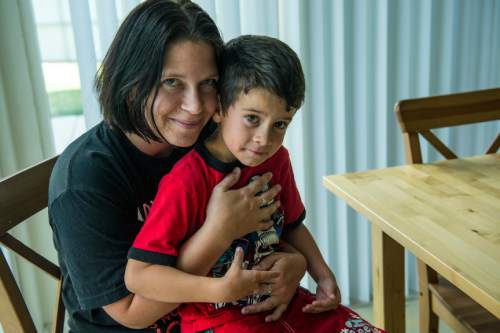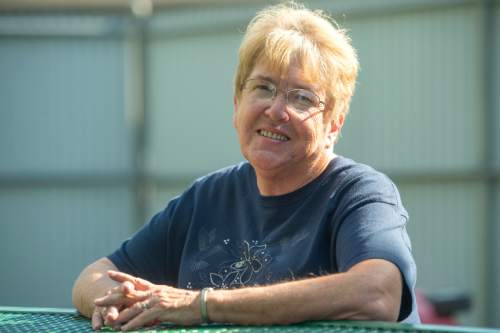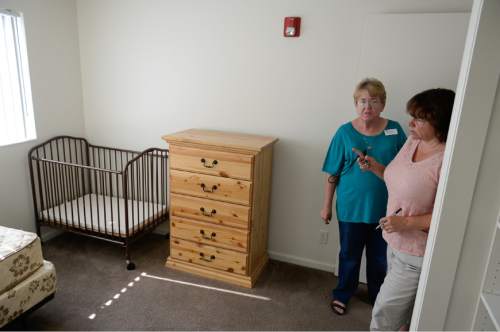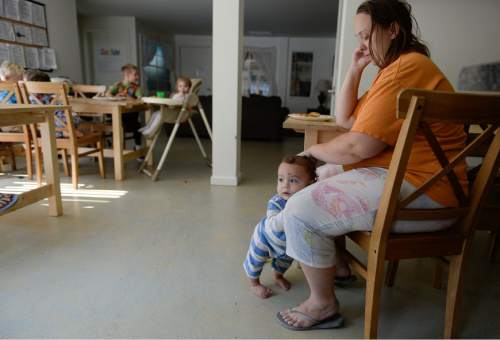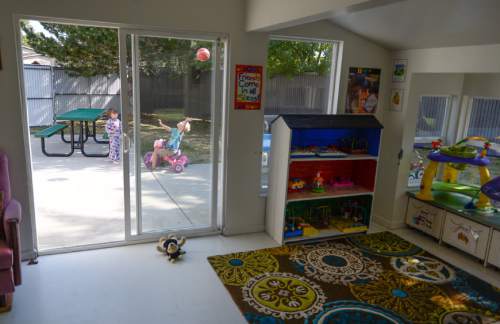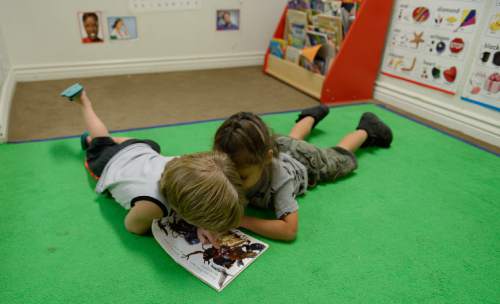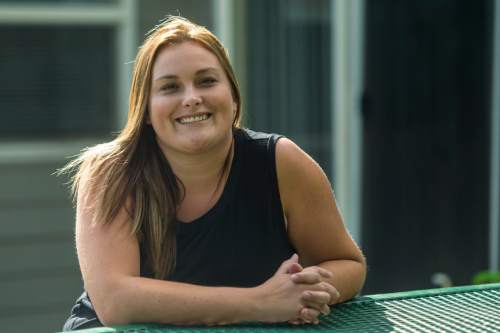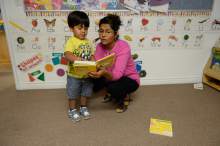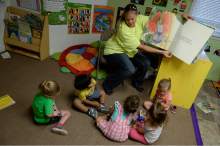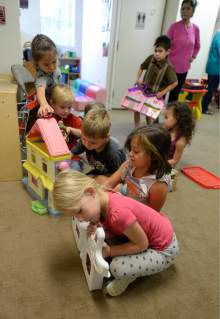This is an archived article that was published on sltrib.com in 2016, and information in the article may be outdated. It is provided only for personal research purposes and may not be reprinted.
Midvale • There is a leafy, well-kept subdivision in this Salt Lake Valley city that doesn't stand out from other suburbs and, to the casual passer-by, wouldn't be recognized as a place where homeless people put their lives and families back together.
But at LifeStart Village, 54 families are leading what look to be normal, everyday lives. There are no miscreants hanging about or other jarring sights and sounds that have become synonymous with The Road Home shelter on Rio Grande Street in downtown Salt Lake City.
For the women and children who live at LifeStart Village, it's an oasis from the nasty dust storm that is homelessness. It encompasses a multifaceted, hands-on program that has yielded a rate of success of about 75 percent, said executive director Bonnie Peters.
Opened in 2003, LifeStart Village is part of the nonprofit Family Support Center, established in 1977, that also offers a free crisis nursery, day care and a host of other services, including counseling, education and an in-home parenting program.
The village stands in stark contrast to the machinations now grinding through Salt Lake City and Salt Lake County as advocates seek to build two new homeless shelters in the capital city that would house 250 to 300 people each in locations yet to be determined. The renderings of the proposed buildings looked institutional to some Salt Lake City Council members who saw them for the first time earlier this month. Some feared the facilities would stick out in a neighborhood setting and be unwelcome.
When LifeStart Village was proposed, many residents complained that it would run down the area, said Midvale Mayor JoAnn Seghini. The opposite happened, she explained. The low-profile village has had a positive influence on surrounding real estate.
—
Solace and healing • For Chelsea Hazel, 28, and her three children, LifeStart Village is a godsend. She is recovering from heroin addiction.
"Without these guys, I'd be in trouble," she said. "I love it here."
Hazel hopes one day when her husband — also a heroin addict — completes treatment, he can join them at LifeStart Village.
"House of Hope turned it around," she said of the addiction-treatment center that referred her to LifeStart. "And having this place where I could come with my kids, it's wonderful."
There are three phases to the LifeStart program conceived by its founder, Jayne Wolfe. But the highly successful program, created in part by grants from the federal Department of Housing and Urban Development (HUD), has now been cut from HUD funding funneled through the county. Without the funding, LifeStart most likely will wither, Peters said.
In Phase I, 11 adults and their children live in a group home with a common kitchen/dining room, living room and play room. The families each have separate living quarters but are assigned communal tasks, including cleaning and cooking.
The place is sparkling, well appointed and washed in light by a lot of windows. Its inhabitants often wear smiles, safe from the grinding desperation of homelessness. LifeStart also works closely with the Boys and Girls Club of Midvale, which offers a host of activities, particularly in the summer, Peters noted.
In Phase I, parents build relationships with other residents, creating support systems.
"It's important for people to sit down and eat together," Peters said. "Learning to cope with other people brings trust and understanding."
Counselors and staffers, who are available 24/7, keep track of the progress — or lack thereof — of the clients through a matrix that keeps tabs in 15 areas, Peters said. If residents are not progressing, counselors help them identify obstacles and move forward.
Clients do not advance to Phase II — individual apartments — until they are ready, according to the program. That can take a year or more.
—
Rapid-rehousing conundrum • Ninety days is not long enough for people to heal from the turmoil of homelessness, said Barbara Stallone, Family Support Center development director, referring to "rapid rehousing" programs that provide three months' rent on private rental properties to participants.
Unlike LifeStart Village, rapid rehousing doesn't build community or support groups. It places single parents — usually single mothers and their children — in neighborhoods where they may have no friends and areas that sometimes lack resources, such as mass transit and child care. After three months, clients must make it on their own — but often, unexpected roadblocks prove to be too much to overcome.
People like Amy Tabor, who recently was evicted from a rapid rehousing Rose Park duplex when her fiance violated parole, end up with a bad rental record as well as huge bills owed in landlord attorney fees and penalties. Jen Carter is being evicted from a bug-infested rapid-rehousing apartment because she lost her job when taking time off to deal with her children. She couldn't afford day care. Kimberly Gross and her two daughters are about to be evicted from a cramped Taylorsville basement unit found through rapid rehousing after she became too ill to work.
Three months of rent without programming and counseling often is not enough to produce successful results, according to Stallone.
"With a single mom, it takes about one year to stabilize," Stallone said. "Rapid rehousing is failing single parents because three months is just not enough time for them to get back on their feet."
In these cases, it appears like a waste of HUD resources. But Matt Minkevitch, executive director of The Road Home, said most rapid-rehousing participants do not return to the shelter.
By contrast to rapid rehousing, LifeStart Village offers day care and other programs for mothers and their children. But LifeStart is not a free ride. Clients must seek work or enroll in school. They are required to pay a share of utilities and food and part of the rent, based on their income. They also must pay for day care.
In Phase II, clients can move to individual duplexes or town houses in the village, but rules remain and counseling continues. The regulations are not draconian, Peters said. They are intended to keep residents in an upward trajectory. Under certain conditions, men can join their wives in Phase II, but they also must follow strict guidelines.
In Phase III, clients can move into rent-to-own houses. Those wishing to participate in Phase III can buy houses in the village after renting them for 15 years. At the end of that period, all the rent paid by the client goes toward a mortgage. The first of those purchases will be possible in 2018, Peters said.
Nonetheless, HUD is shifting priorities away from "transitional housing," such as LifeStart Village, to rapid rehousing, said Shaleane Gee, director of special projects for Salt Lake County.
She is county Mayor Ben McAdams' point person on the Collective Impact initiative that seeks to better tap funding for homeless services.
LifeStart Village "is a model we know we need more of," Gee said. "But, at the federal level, there has been a movement toward rapid rehousing."
Many advocates say rapid rehousing is key to treating homelessness. But without data on success rates, which appear to be unavailable, that assumption remains unsubstantiated.
"Services and rapid rehousing must go hand in hand," Gee said. "Or it may be a crap shoot."


